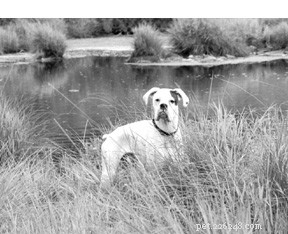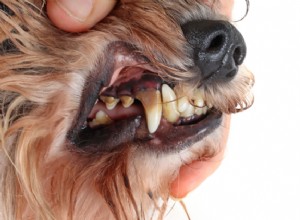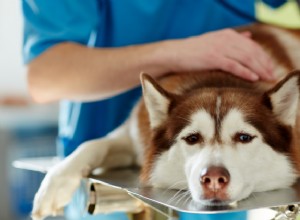Shannon Wilkinson 작성
1999년 6월, 부커, 10개월 반 된 그레이트 데인이 다시 쓰러졌습니다. 불과 4일 전 그는 신장병 진단을 받았습니다. 입원과 수액은 첫 번째 붕괴 이후에 그를 엄청나게 도왔습니다. 그는 심지어 다시 먹기 시작했다. 지금 무엇이 잘못되었을 수 있습니까?
우리는 그를 수의사에게 데려갔습니다. 이번에는 부커가 너무 허약해서 대기실 바닥에서 일어나지 못했다. 수의사는 그곳에서 그를 검사했지만 즉각적인 대답은 없었습니다. 그는 우리에게 더 많은 테스트와 IV를 위해 밤새 부커를 떠나라고 요청했습니다. 마지못해 그렇게 했습니다.

그날 늦게 수의사는 좋은 소식과 나쁜 소식을 가지고 전화를 했습니다. 좋은 소식은 전문가들과 상의한 결과, 그가 문제를 즉시 치료할 수 있는 상태인 애디슨병으로 식별했다는 것입니다. 그리고, 나쁜 소식? 애디슨병은 고가의 약과 정기적인 혈액 검사를 포함하여 평생 관리가 필요한 만성 건강 문제입니다.
애디슨병은 부신피질기능저하증 또는 부신기능부전의 일반적인 이름입니다. 부신은 혈압을 조절하기 위해 나트륨과 칼륨 수치를 유지하는 알도스테론(다른 중요한 기능 중에서도)과 신체가 포도당을 대사하고 포도당을 효과적으로 처리하는 데 도움이 되는 코르티솔을 비롯한 많은 호르몬을 충분히 생산하지 않습니다. 모든 종류의 육체적 정신적 스트레스. 사람뿐만 아니라 동물에게도 발생할 수 있습니다.
두 개의 부신은 각 신장의 상단에 있으며 때때로 부신이라고도 합니다. 그들은 외부 피질과 내부 수질의 두 층으로 구성됩니다. 피질은 코티솔과 같은 글루코코르티코이드와 알도스테론과 같은 무기질 코르티코이드를 분비합니다. 교감 신경계의 일부인 부신의 수질 영역은 에피네프린을 분비하며 일반적으로 애디슨병의 영향을 받지 않습니다.
애디슨병에는 원발성, 속발성, 비정형의 세 가지 유형이 있습니다. 원발성 및 비정형 애디슨병은 일반적으로 땀샘에 대한 면역 매개 손상의 결과입니다. 속발성 부신피질기능저하증은 뇌하수체가 부신피질자극호르몬(ACTH)으로 부신을 자극하지 못하는 것입니다. 이는 대부분 장기간 코르티코스테로이드 요법(예:프레드니손)의 결과이며 종양, 외상 또는 뇌하수체 기형으로 인해 발생할 수도 있습니다.
애디슨은 누가 얻나요?
연구에 따르면 일부 품종은 다른 품종에 비해 애디슨병에 걸릴 가능성이 더 높습니다. 예를 들어, 한 연구에 따르면 다른 모든 견종에 비해 웨스트 하이랜드 화이트 테리어가 6배, 그레이트 데인이 에디슨의 영향을 받을 가능성이 7배 더 높습니다.
다른 연구에 따르면 스탠다드 푸들은 거의 9배, 휘튼 테리어는 거의 7배, 포르투기저 워터독은 다른 품종보다 46배 이상 영향을 받을 가능성이 더 높습니다.
같은 연구에 따르면 달마시안, 핏불 테리어, 골든 리트리버 및 소수의 다른 품종이 다른 모든 품종에 비해 애디슨병이 발병할 가능성이 낮습니다.
캘리포니아 대학(University of California, Davis)의 아니타 오버바우어(Anita Oberbauer) 교수 박사는 품종 통계에서 알 수 있듯이 질병에 유전적 요소가 있는지 확인하기 위한 연구를 수행하고 있습니다. Bearded Collies, Standard Poodles, Leonbergers 및 Portugal Water Dogs에 대한 정보가 수집되고 있습니다. Oberbauer 박사에 따르면 "우리가 Beardies에 대해 가지고 있는 데이터는 확인된 주요 유전자가 없는 다유전자 유전 방식을 제안합니다." Standard Poodles에 대한 데이터는 또한 다유전자 방식의 유전을 제안하지만 "큰 영향을 미치는 단일 유전자좌/유전자"를 가지고 있습니다. 그러나 그녀는 영향을 받은 푸들이 영향을 받은 푸들에 대한 확실한 교배에 대해 알지 못하기 때문에 그것이 실제로 단일 유전자임을 보여주는 데이터가 아직 없다는 것을 인정합니다.
흥미롭게도 일부 연구에 따르면 애디슨병에 걸린 개의 70~85%가 암컷이며 영향을 받은 개는 가장 흔히 4~7세입니다. 그러나 애디슨병은 개의 나이와 성별에 관계없이 고전적인 증상이 나타날 때마다 의심해야 합니다.
증상
애디슨병을 제대로 진단하는 데 있어 어려운 것 중 하나는 증상의 일반적인 왁싱과 약화입니다. DVM의 Karen Ivin은 "기복이 있는 개를 대상으로 애디슨병 검사를 항상 고려하고 있습니다. 옳지 않지만 완전히 아프지도 않은 경우."
Ivin 박사는 애리조나 주 길버트에 소규모의 가정방문 중심의 전체론적 진료를 갖고 있습니다. 애디슨 병은 종종 "희귀한"것으로 묘사되지만 그녀는 애디슨 병을 앓고있는 여러 개를 치료하고 있으며 주어진 시간에 항상 고객 중 몇 명을 가지고 있습니다. 그녀는 연습에 애디슨 병이 있는 개 두어 마리가 없는 수의사는 그것을 보지 못한다고 생각합니다. 제약 회사 Novartis에 따르면 "각각 연간 1,500마리의 개를 보는 2명의 수의사가 있는 일반적인 관행은 매년 평균 1건의 부신 기능 부전을 진단할 것으로 예상해야 합니다."
증상은 미묘할 수 있으며 종종 다른 많은 질병에서 흔히 나타나는 증상을 모방합니다. 전형적인 증상은 다음과 같습니다:우울증 또는 혼수; 신경성 식욕 부진증; 체중 감량; 구토; 흔들리거나 떨림; 약점; 설사. 종종 개는 구토나 허약함과 같은 에피소드를 경험할 수 있으며, 이는 수액 또는 스테로이드 투여로 해결됩니다. 불행히도 일반적으로 증상이 다시 나타납니다.
이것은 우리의 두 번째 개인 타일러와의 경험이었습니다. 우리는 8개월 된 2001년 6월에 복서인 타일러를 입양했습니다. 그는 매우 말랐고 정기적으로 설사를 했습니다. 2001년 추수감사절에 간병인과 함께 지낸 후 그는 혈변을 일으켰습니다. 부커와의 경험으로 인해 타일러는 애디슨병 검사를 받았습니다. 좋은 소식입니다. 그의 결과는 부정적이었습니다. 하지만 3개월 후 타일러가 이틀 동안 네 번 토한 후 다시 검사를 받았습니다. 이번에는 결과가 비정형 애디슨에 대해 긍정적이었습니다. Addisonian 개는 질병 발병 당시 암컷이나 4~7세 사이가 아니었습니다.
애디슨병 진단
두 개의 애디슨병 진단은 유일한 최종 진단 도구인 ACTH 반응 또는 자극 검사로 확인되었습니다. 이 검사에서는 기준선 코르티솔 수치를 결정하기 위해 혈액을 채취합니다. 동물에게 ACTH를 주사합니다. 약 1시간 후 다시 혈액을 채취하여 코티솔 수치를 측정합니다.
건강하고 정상적인 부신 땀샘을 가진 개의 기준 코티솔 수치는 1-4 마이크로그램/데시리터입니다. 코티솔 수치는 자극 후 6~20마이크로그램/데시리터 범위로 상당히 높아야 합니다. 안정시 코르티솔이 낮고 강아지가 자극에 대한 반응이 없거나 낮은 경우 진단은 애디슨병입니다.
혈액 검사 결과의 특정 값은 Addison의 가능성을 나타낼 수도 있습니다. 여기에는 높은 칼륨(고칼륨혈증), 낮은 나트륨(저나트륨혈증), 낮은 나트륨 대 칼륨 비율(Na/K), 빈혈, 질소혈증 또는 요독증(높은 수준의 질소), 호산구 증가증(호산구라고 하는 백혈구 증가), 림프구증가증( 림프구라고 하는 백혈구의 상승), 간 효소 상승(ALT/AST) 및 1.030 미만의 소변 비중.
기존 치료
갑상선 기능 저하증이나 당뇨병과 같은 애디슨병에 대한 기존의 치료법은 누락된 호르몬을 대체하는 것입니다. 원발성 애디슨병의 경우 무기질코르티코이드와 당질코르티코이드를 모두 교체해야 합니다. 비정형 및 속발성 애디슨병은 글루코코르티코이드만 교체해야 합니다.
미네랄 코르티코이드인 알도스테론을 대체할 수 있는 두 가지 약물이 있으며 이 두 약물은 신체가 나트륨과 칼륨을 정상 수준으로 유지하는 데 도움이 됩니다. 첫 번째인 플루드로코르티손 아세테이트(브랜드명 Florinef™)는 매일 경구 투여됩니다. 다른 옵션은 일반적으로 25~28일마다 투여하는 주사제인 데옥시코르티코스테론 피빌레이트 또는 DOCP(Percorten-V™)입니다.

Fludrocortisone acetate 또는 Florinef는 애디슨병 환자가 선택하는 미네랄 코르티코이드입니다. 대부분의 사람들은 하루에 1/2에서 2개의 0.1mg 정제를 섭취합니다. 그러나 개는 약물을 효율적으로 대사하지 않으며 체중 10파운드당 플루드로코르티손 0.05 – 0.1mg의 용량으로 시작해야 합니다. 일부 개는 전해질 수준을 조절하기 위해 더 높은 용량이 필요합니다.
기존 약국에서 구입한 Florinef의 가격은 0.1mg 정제당 약 50센트에서 정제당 1달러에 가깝습니다. 50파운드의 개는 한 달에 $75에서 $150의 비용으로 0.1mg 정제 중 약 5개가 필요합니다. 그러나 플루드로코르티손에 대한 더 저렴한 대안이 있습니다.
온타리오에 기반을 둔 인터넷 수의학 약국인 Pet Pharm은 플로리네프 100정에 대해 캐나다 달러 약 35달러를 청구합니다. 최근 환율로 미국 달러로 환산하면 100정당 23달러 미만이다. 이 가격으로 50파운드 개를 위한 약은 한 달에 약 $35입니다. 이것은 Florinef를 훨씬 더 저렴하게 만들지 만 대형 개가있는 경우에도 매일 여러 개의 작은 정제를 복용하는 데 어려움을 겪습니다. (장기 약품 가격 인하에 대한 자세한 내용은 WDJ 2002년 9월호 "Prescriptions of Prescriptions"를 참조하십시오.)
유명 브랜드의 정제를 구입하는 대신 조제 약사가 처방전을 캡슐, 액체 또는 향이 첨가된 씹는 형태로 맞춤화하도록 하는 것입니다. 편의성 외에도 복합 의약품은 브랜드 이름에 비해 훨씬 저렴할 수 있습니다. 뉴저지주 웨스트필드에 있는 한 합성 약국인 Tiffany Natural Pharmacy는 0.5mg 캡슐 100개에 대해 약 45달러를 청구합니다. 하루에 한 캡슐로 50파운드짜리 개를 치료하는 데 한 달에 13.50달러에 해당합니다.
애디슨병이 있는 동물에게만 사용되는 주사제인 Percorten-V는 구매 옵션이 더 적습니다. 많은 보호자가 강아지에게 매달 Percorten 주사를 맞도록 하여 필요한 경우 수의사가 강아지의 전해질을 테스트하고 체중 변화를 확인하며 강아지의 전반적인 건강과 태도를 모니터링할 수 있도록 합니다.
하지만 시간이 지나면 보호자가 집에서 주사를 맞고 싶을 수도 있습니다. 이것은 약간의 비용을 절약할 수 있을 뿐만 아니라 스트레스도 줄일 수 있습니다. 퍼코르텐 제조사인 노바티스는 FDA 승인 과정에서 근육주사 방식을 사용했기 때문에 근육주사를 권장하고 있다. 그러나 미국 동물 병원 협회 저널(Journal of American Animal Hospital Association)에 발표된 후속 연구에 따르면 피하 주사를 쉽게 하는 것도 그만큼 효과적이라는 사실이 밝혀졌습니다.
Florinef와 마찬가지로 Percorten의 복용량은 체중에 따라 다릅니다. 표준 용량은 체중 파운드당 1mg입니다. 약은 4ml 병에 들어 있으며 각 ml에 약 25mg이 있습니다. 따라서 50파운드의 개는 50mg 또는 2ml의 Percorten이 필요합니다.
Percorten은 수의사와 동물 약국에서만 구입할 수 있습니다. 가격은 클리닉 또는 약국 마크업에 따라 크게 다릅니다. Booker가 처음 진단되었을 때 첫 번째 ml에 대해 $60, 이후에는 각 ml에 대해 $40가 청구되었습니다. 그렇게 하면 50파운드짜리 개를 위한 월간 주사 비용이 약 $100가 됩니다. 하지만 가격에 100% 이상의 인상률이 포함되어 있다는 사실을 곧 알게 되었습니다.
우리는 애디슨병에 걸린 개는 약물 외에도 정기적인 혈액 검사와 진료실 방문이 필요하다는 점을 지적하여 수의사와 가격을 협상했습니다. (개 소유자는 다른 많은 장기 약물과 마찬가지로 수의사의 처방이 있더라도 인터넷 약국에서 Percorten을 구입하지 못할 수 있습니다. 왼쪽 하단의 사이드바 참조)
Amy Rogers의 Rottweiler, Venus는 최근 Addison의 진단을 받았습니다. 처음에 그녀의 수의사는 Percorten 주사로 Venus를 시작했고 경구 약물의 옵션에 대해서도 논의하지 않았습니다. However, Amy has recently switched Venus, under the watchful eye of her vet, from the injections to compounded fludrocortisone. This change will save Rogers about $80 per month.
In addition to replacing the mineralocorticoids, dogs with Addison’s disease need the glucocorticoid, cortisol, replaced as well. About 50 percent of dogs require daily glucocorticoid supplementation, while all dogs with Addison’s require glucocorticoid supplementation in times of stress.
Stress is individual. It can come in many forms – physical or emotional, good or bad. For instance, some dogs may require extra glucocorticoids for a visit to the vet, while other dogs may need them because of an extra long play session. While it is important to observe all dogs with Addison’s closely, knowing each individual dog’s stressors is crucial.
There are a number of glucocorticoids available to replace the cortisol that the adrenals are no longer producing. Most vets recommend using prednisone, while most people with Addison’s take hydrocortisone. The other glucocorticoids used include prednisolone, methylprednisolone, and dexamethasone. These all tend to be inexpensive medications.
You many recognize prednisone as the steroid frequently prescribed for allergic reactions, skin problems, or autoimmune conditions. However, its use with the Addisonian patient is at far smaller physiological doses, rather than the therapeutic doses often used for anti-inflammatory and other situations. The typical recommended dosage of prednisone is 0.1 – 0.2 mg per pound per day. That is 5 – 10 mg per day for a 50-pound dog.
However, many people find that on these doses their dog with Addison’s shows undesirable symptoms such as excessive drinking and urination, increased appetite, infections, even behavioral changes. Because these dogs will be on medications for the rest of their lives, it is important to fine-tune the dosages to maximize benefits, while minimizing unwanted side effects.
If a dog suffers from side effects of prednisone, it might be worth trying hydrocortisone instead. That’s what I found with Booker. He was on 15 mg of prednisone every other day. Yet he was unable to go more than four hours without urinating, was having recurring skin infections, and was balding on his face, chest, legs, and abdomen. After switching to hydrocortisone under the care of our vet, his dose was reduced significantly and these problems went away.
Of course, any of these medications require a prescription from your primary veterinarian. It is important, particularly with Addison’s disease, that your dog is monitored closely through observation and blood tests. Always work with your vet when exploring changes in medications.
Complementary therapies
According to most experts, there is no replacement for the conventional medications required to treat Addison’s disease. However many believe that the quality of life can be improved and medications even reduced by using various supplements, improving the dog’s diet, and incorporating complementary modalities such as acupuncture and TTouch.
Booker is a perfect example of how complementary therapies can enhance conventional treatment. Months after diagnosis, Booker was clinically stable with excellent blood test results, but he was still experiencing a number of problems, such as digestion issues, skin problems, and low energy levels.
After incorporating a variety of complementary therapies including Western and Chinese herbs, TTouch, acupuncture, supplements, and a raw, whole food diet, his digestion is greatly improved and his energy level is higher than as a puppy. In addition, his medications have been reduced significantly. At the time of switching him to hydrocortisone, he was taking 30 mg per day. He now takes 7.5 mg per day. He also was receiving 6.4 ml of Percorten-V every four weeks. This has been reduced over 65 percent to 3.2 ml every six weeks.
Many vets agree that diet is the key to a foundation of health for any dog. Before focusing his efforts on diet, Ian Billinghurst, BVSc, studied acupuncture and met with herbalists and homeopaths trying to determine what has the greatest impact on the health of our dogs. He learned that without a good diet, therapies such as acupuncture and homeopathy won’t work properly.
Gloria Dodd, DVM, agrees. She believes that diet accounts for 70 percent of the treatment for an ill dog and this is the first change she encourages clients to make. Both Billinghurst and Dodd are proponents of a raw, fresh, whole foods diet designed for carnivores.
While Dr. Ivin recognizes the importance of diet in the overall health and treatment of an animal, she doesn’t believe it has to be raw, or even home-cooked. However, the commercial food must be of top quality.
One of the most frequently recommended complementary treatments for Addison’s is also one of its original treatments:glandular supplementation. Before the discovery of cortisol, and later its synthetic analogs cortisone and prednisone, patients with Addison’s disease were given ground-up or extract of adrenal gland. Now the process has evolved and a number of companies, such as Standard Process and Nutriwest, manufacture glandular products in tablet or capsule form.
“The addition of glandulars may sometimes help reduce the medication levels of my patients,” says Dr. Ivin, “but they nearly always improve how the dog feels on a day-to-day basis.” She says they help reduce fluctuations in the disease process, help keep the dogs stable, and decrease deterioration as they age.
Various herbs may be beneficial, including nutritive herbs that supply vitamins and minerals necessary for adrenal functions, such as dried nettle, dandelion, parsley, and spirulina; those that support adrenal function, like licorice and borage; those that help the liver, like milk thistle; and those that reduce the impact of stress, such as astragulus and ginseng.
The herb licorice has been reported to have a positive effect with Addison’s disease. Research has shown that licorice helps prolong the activity of natural and synthetic corticosteroids like hydrocortisone, which may enhance the activity of medications or even allow dosage reductions.
Dr. Ivin uses Chinese herbal formulas with great success. Because, as with homeopathy, Chinese herbal remedies are prescribed on an individual basis, she may use a variety of formulas depending on the particular symptoms of her patient. Most of the formulas that she chooses contain the key ingredient, ginseng. Ginseng is an adaptogenic herb that helps the body adapt to environmental and emotional stressors and supports all the major systems of the body rather than having strong affinities for any one system or organ.
Since Addison’s disease inhibits the body’s ability to effectively deal with stress, reducing stress and keeping your dog’s life stable is important. “Maintaining a low-stress, stable environment for your dog helps limit the necessary changes in medication,” says Dr. Ivins. She has found that flower essences are helpful in reducing stress and limiting the need for extra glucocorticoids.
Acupuncture and chiropractic care may also be beneficial. Dr. Dodd believes strongly that in addition to medications, supplements, and diet, it is necessary to treat the imbalances in the acupuncture energy flow meridians of the endocrine glands, digestive organs, immune system, and kidneys.
Post diagnosis follow-up
Immediately after diagnosis, and whenever any changes are made to medications or supplements, it is important to perform blood tests to ensure the dog is stabilized. The electrolyte levels offer the most specific information, particularly about the efficacy of the mineralocorticoids. However, thorough blood work including a full chemistry panel, complete blood count, and thyroid panel are helpful in determining the overall health of an animal.
Thorough management of an Addison’s patient, and fine-tuning his medications and treatments to maximum effect can be difficult, especially with so many variables. Dr. Ivin encourages owners to work closely with their veterinarians to understand the disease as much as possible. “There is no such thing as a dumb question,” she says. Dr. Ivin also recommends keeping track of everything, including the dog’s activity level. Without a written record, it is difficult to know the impact of changes made in medications, supplements, diet, or other therapies.
While managing Addison’s disease can be daunting, it is not impossible. The greatest motive for working at it is the day-to-day health and longevity of your dog. Research shows that when properly stabilized, Addison’s disease does not seem to impact the longevity of a dog.
Dr. Ivin recently lost a canine patient with Addison’s this summer. The Australian Shepard was diagnosed at about eight years old and died at 16. Now that is worth working toward.
이 문서와 함께
Click here to view “Addison’s Disease in Dogs”
Click here to view “Addison’s Disease in Dogs:Detections and Treatment”
———-
Shannon Wilkinson is a TTouch practitioner and freelance writer who lives with her husband and two Addisonian dogs in Portland, Oregon. 이것은 WDJ에 대한 그녀의 첫 번째 기사입니다.

개의 치주(잇몸) 질환은 개의 가장 흔한 건강 문제 중 하나이며 모든 개의 거의 90%가 2세까지 잇몸 질환의 징후를 보입니다 . 개는 치주 질환의 증상을 거의 나타내지 않으므로 상태를 발견하기 어렵습니다. . 치료하지 않으면 잇몸 미란, 만성 통증, 치아 상실이 발생할 수 있습니다. . 박테리아 감염은 또한 개의 입에서 신체의 다른 부분으로 퍼질 수 있습니다 , 심장이나 신장과 같이 더 심각한 건강 결과를 초래합니다. 송곳니 치주 질환은 치료가 불가능하지만, 쉽게 예방할 수 있습니다. 이 게시물에서는 개가 잇몸병에 걸리는 방법

개 부신피질기능저하증으로도 알려진 애디슨병은 개에게 심각한 결과를 초래할 수 있는 상태입니다. 다행히도 적절한 치료를 받으면 애디슨병에 걸린 강아지가 정상적인 삶을 영위할 수 있습니다. 개의 애디슨병 증상, 진단 방법, 사용 가능한 치료 옵션 등에 대해 자세히 알아보려면 계속 읽으십시오. 목차: 개 애디슨병이란? 애디슨병의 원인은 무엇입니까? 애디슨병의 증상은 무엇입니까? 애디슨병 증상을 유발하는 요인은 무엇입니까? 애디슨 위기란 무엇입니까? 애디슨병은 어떻게 진단되나요? 개의 애디슨병은 어떻게 치료하나요? 애디슨병 치료 비